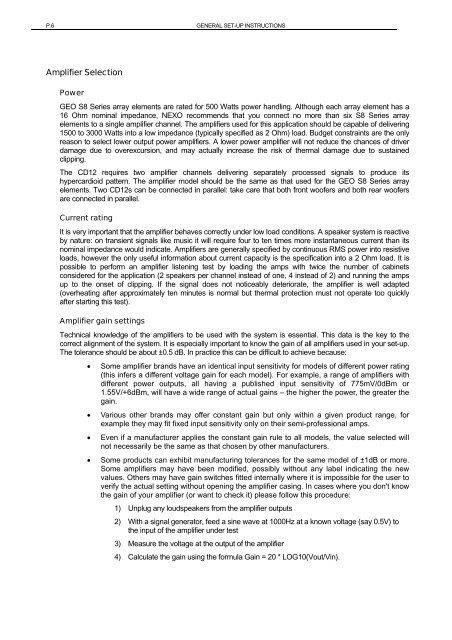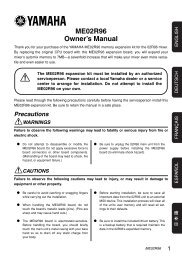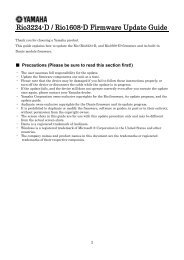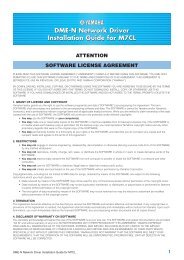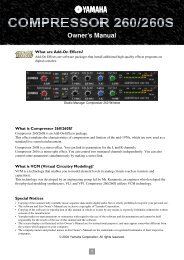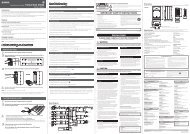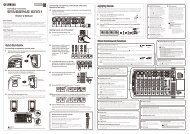Create successful ePaper yourself
Turn your PDF publications into a flip-book with our unique Google optimized e-Paper software.
P.6 GENERAL SET-UP INSTRUCTIONSAmplifier SelectionPower<strong>GEO</strong> S8 <strong>Series</strong> array elements are rated for 500 Watts power handling. Although each array element has a16 Ohm nominal impedance, NEXO recommends that you connect no more than six S8 <strong>Series</strong> arrayelements to a single amplifier channel. The amplifiers used for this application should be capable of delivering1500 to 3000 Watts into a low impedance (typically specified as 2 Ohm) load. Budget constraints are the onlyreason to select lower output power amplifiers. A lower power amplifier will not reduce the chances of driverdamage due to overexcursion, and may actually increase the risk of thermal damage due to sustainedclipping.The CD12 requires two amplifier channels delivering separately processed signals to produce itshypercardioid pattern. The amplifier model should be the same as that used for the <strong>GEO</strong> S8 <strong>Series</strong> arrayelements. Two CD12s can be connected in parallel: take care that both front woofers and both rear woofersare connected in parallel.Current ratingIt is very important that the amplifier behaves correctly under low load conditions. A speaker system is reactiveby nature: on transient signals like music it will require four to ten times more instantaneous current than itsnominal impedance would indicate. Amplifiers are generally specified by continuous RMS power into resistiveloads, however the only useful information about current capacity is the specification into a 2 Ohm load. It ispossible to perform an amplifier listening test by loading the amps with twice the number of cabinetsconsidered for the application (2 speakers per channel instead of one, 4 instead of 2) and running the ampsup to the onset of clipping. If the signal does not noticeably deteriorate, the amplifier is well adapted(overheating after approximately ten minutes is normal but thermal protection must not operate too quicklyafter starting this test).Amplifier gain settingsTechnical knowledge of the amplifiers to be used with the system is essential. This data is the key to thecorrect alignment of the system. It is especially important to know the gain of all amplifiers used in your set-up.The tolerance should be about ±0.5 dB. In practice this can be difficult to achieve because:• Some amplifier brands have an identical input sensitivity for models of different power rating(this infers a different voltage gain for each model). For example, a range of amplifiers withdifferent power outputs, all having a published input sensitivity of 775mV/0dBm or1.55V/+6dBm, will have a wide range of actual gains – the higher the power, the greater thegain.• Various other brands may offer constant gain but only within a given product range, forexample they may fit fixed input sensitivity only on their semi-professional amps.• Even if a manufacturer applies the constant gain rule to all models, the value selected willnot necessarily be the same as that chosen by other manufacturers.• Some products can exhibit manufacturing tolerances for the same model of ±1dB or more.Some amplifiers may have been modified, possibly without any label indicating the newvalues. Others may have gain switches fitted internally where it is impossible for the user toverify the actual setting without opening the amplifier casing. In cases where you don't knowthe gain of your amplifier (or want to check it) please follow this procedure:1) Unplug any loudspeakers from the amplifier outputs2) With a signal generator, feed a sine wave at 1000Hz at a known voltage (say 0.5V) tothe input of the amplifier under test3) Measure the voltage at the output of the amplifier4) Calculate the gain using the formula Gain = 20 * LOG10(Vout/Vin).


